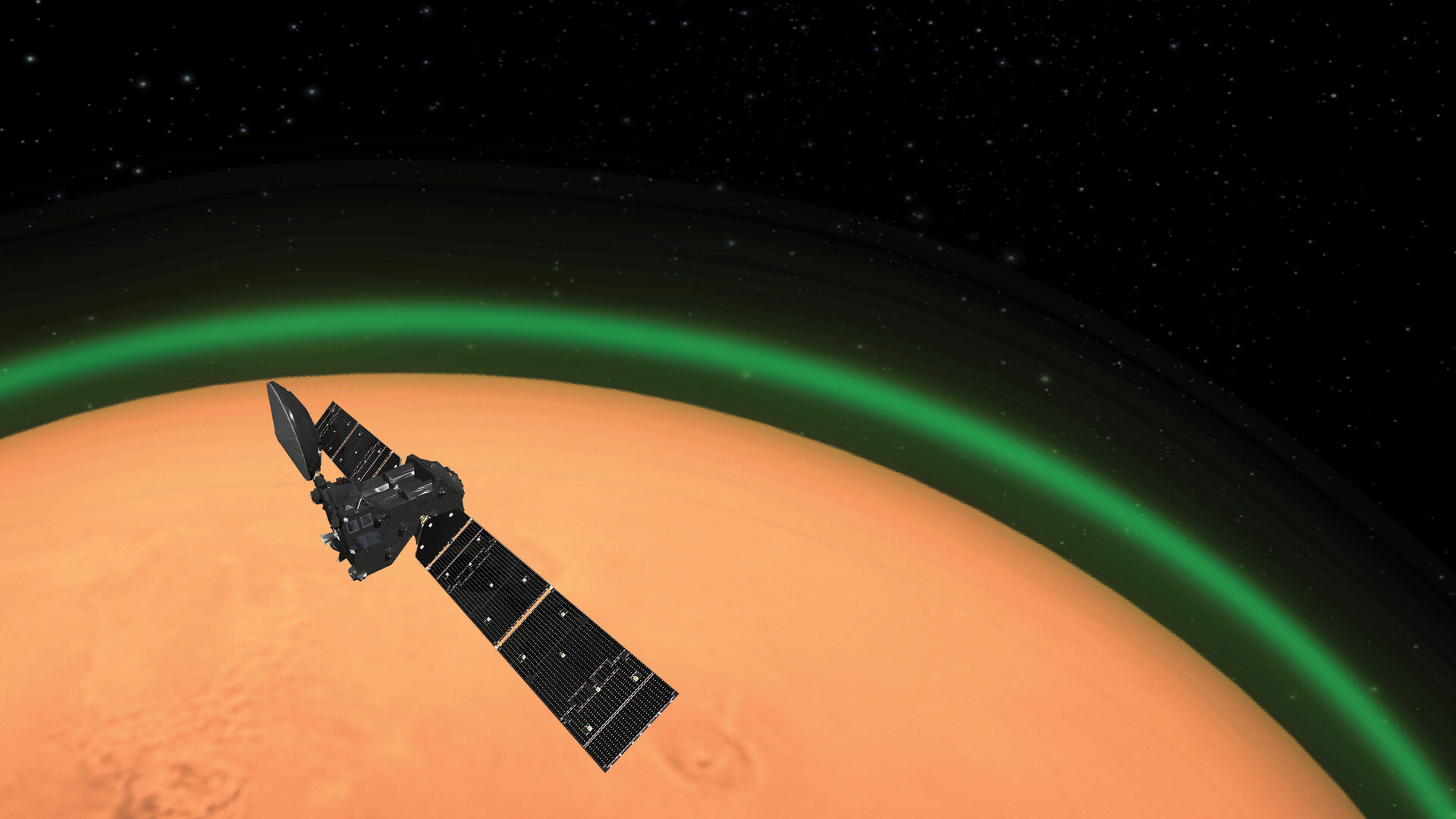
On Earth, there is a phenomenon known as nightglow, where the atmosphere experiences faint light emissions that prevent the night sky from becoming completely dark. This is caused by various processes in the upper atmosphere, like the recombination of atoms, cosmic rays striking the atmosphere, or oxygen and nitrogen interacting with hydroxyl a few hundred kilometers from the surface. Thanks to data obtained by the ESA’s ExoMars Trace Gas Orbiter (TGO), the same phenomenon has been observed in the Martian atmosphere for the first time.
While scientists have long suspected that Mars also experiences this atmospheric phenomenon, this is the first time that effectively proves it. The revelation was made by an international team of scientists based on their analysis of data from the TGO’s Nadir and Occultation for MArs Discovery (NOMAD) spectrometer. When astronauts and rovers explore Mars’ polar regions in the near future, they will see a green glow whenever they look up at the sky and could even use the glow to navigate and find their way in the dark of night.
The study was led by Jean-Claude Gérard, a Professor at the University of Liege’s Laboratory for Planetary and Atmospheric Physics/Star Research Institute (IPAP-STAR). He was joined by researchers from the Royal Belgian Institute for Space Aeronomy (BIRA-IASB), the School of Physical Sciences at The Open University, and the Instituto de Astrofìsica de Andalucía (IAA-CSIS). The paper that describes their findings, titled “Observation of the Mars O2 visible nightglow by the NOMAD spectrometer onboard the Trace Gas Orbiter,” recently appeared in Nature Astronomy.
The atmospheric nightglow occurs on Mars when elemental oxygen combines to form oxygen gas (O2) about 50 km (31 mi) above the planetary surface. These atoms originate on Mars’ dayside, where sunlight excites carbon dioxide molecules and causes them to split into their constituent components. When they migrate to the night side and are no longer energized by the Sun, they regroup and emit light at lower altitudes. The illumination could be bright enough to navigate by, as bright as moonlit clouds on Earth.
Nightglow is not to be confused with auroras, which result from energetic electrons from the Sun interacting with Earth’s magnetic field and upper atmosphere. A similar process occurs on Mars, resulting from solar electrons striking the upper atmosphere. While aurorae vary across space and time, nightglows are more homogeneous, both can display a wide range of colors depending on which atmospheric gases are most abundant at different altitudes. Astronauts routinely observe nightglow edge-on in Earth’s atmosphere from the International Space Station (ISS) and have taken breathtaking pictures of them.
The international team was motivated by previous observations made by the ESA’s Mars Express, which observed the nightglow above the planet’s limb on three occasions (in 2004, 2005, and 2006, respectively). These events were spotted during a series of 40 infrared observations made by the Mars Express Observatoire pour la Minéralogie, l’Eau, les Glaces et l’Activité (OMEGA) imaging spectrometer, provided by the French Space Agency – Centre National D’Etudes Spatiales (CNES). The TGO followed this up by capturing the dayglow high above the dayside of Mars in 2020 with its NOMAD instrument.
“This emission is due to the recombination of oxygen atoms created in the summer atmosphere and transported by winds to high winter latitudes, at altitudes of 40 to 60 km in the Martian atmosphere,” said co-author Lauriane Soret, a researcher from the IPAP at the University of Liège, in a recent ESA press release. “These observations are unexpected and interesting for future trips to the Red Planet,” added lead author Gérard.
The NOMAD experiment is led by researchers from the BIRA-IASB in collaboration with teams from Spain (IAA?CSIC), Italy (INAF?IAPS), the United Kingdom (Open University), and others. The instrument covers a spectral range from about 100 to 700 nanometers, corresponding to the near ultraviolet to red light wavelengths. It was also oriented towards the edge of the Red Planet while the TGO was orbiting at an altitude of 400 km (250 mi), allowing it to better observe the upper atmosphere on the night side of Mars.
This data could provide valuable insight into the Martian atmosphere, providing a wealth of information about the composition, dynamics, and oxygen density of a region that is difficult to measure. It can also reveal how sunlight and solar-charged particles (aka. solar wind) deposit energy into the atmosphere. This information is essential when planning future missions to Mars, especially where atmospheric density is concerned, which affects the drag experienced by orbiters and the parachutes used to deliver robotic missions to the surface.
Yet again, these findings demonstrate that Mars and Earth share some key similarities arising from their similar compositions (terrestrial or rocky) and the dynamic processes that drive their atmospheres. In the near future, multiple space agencies hope to send crewed missions there to conduct in-depth research that will likely reveal that our two planets have had similar pasts. These missions may also reveal evidence of past life on Mars and possibly evidence that life still exists there today!
Further Reading: ESA, Nature Astronomy
